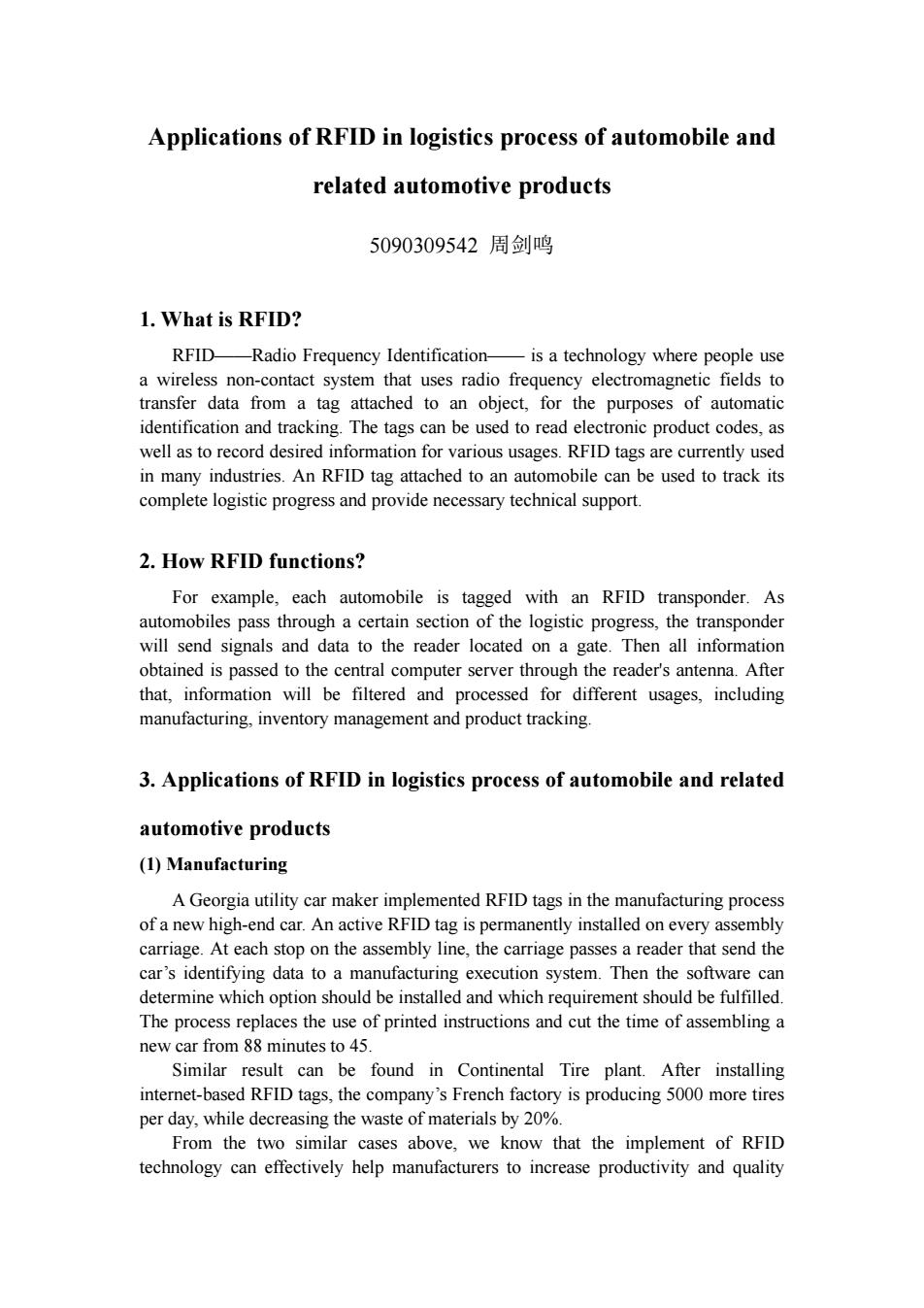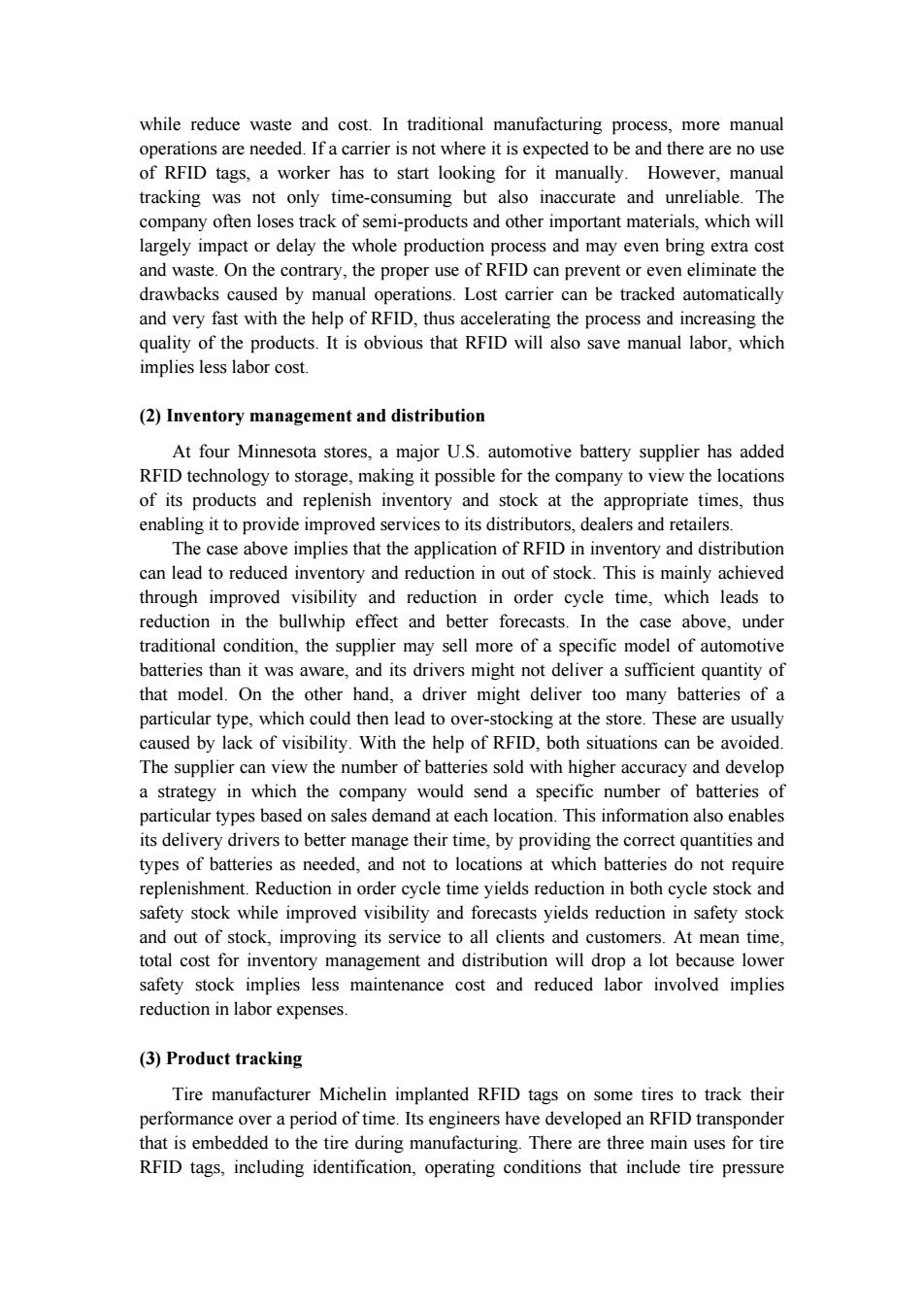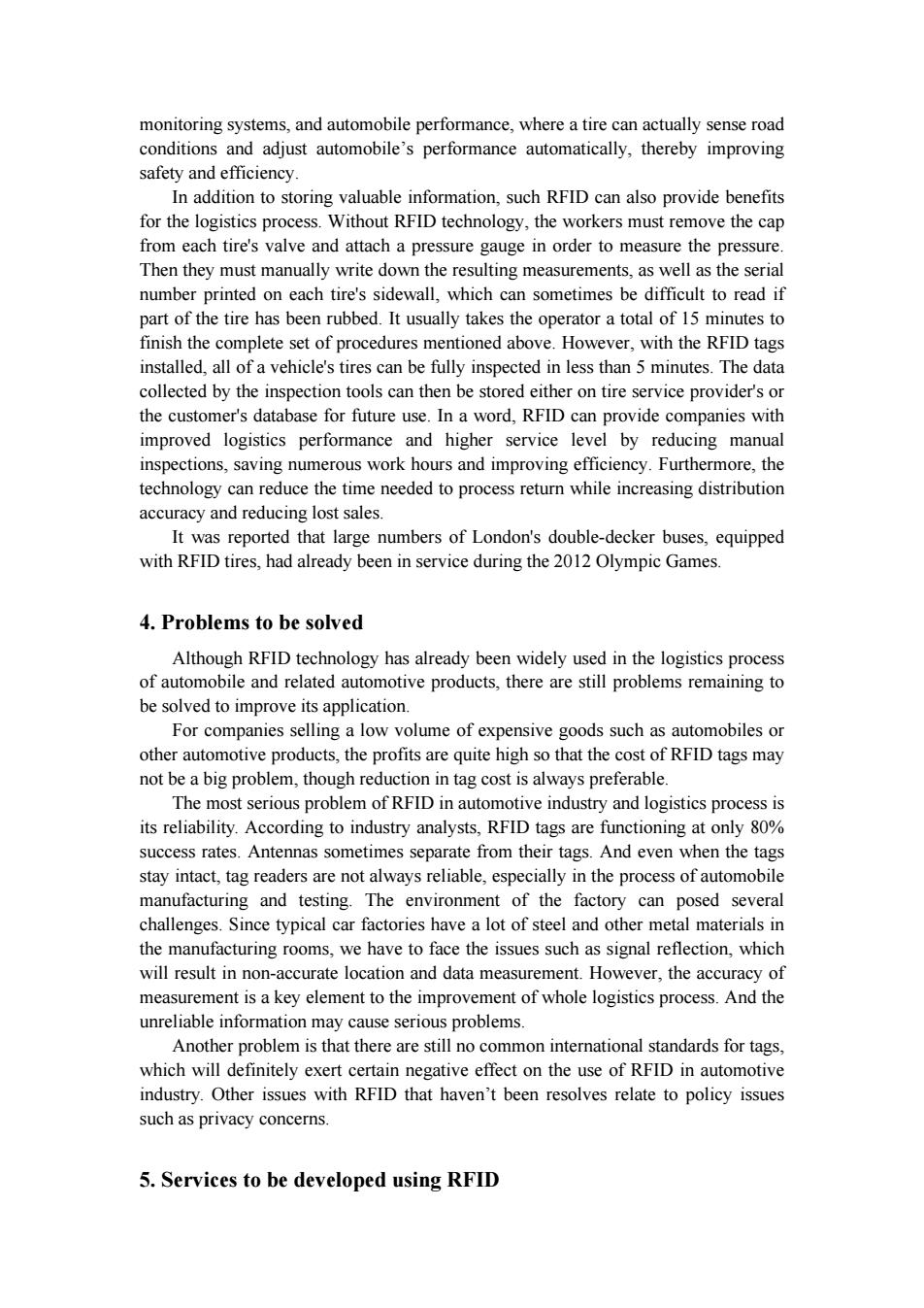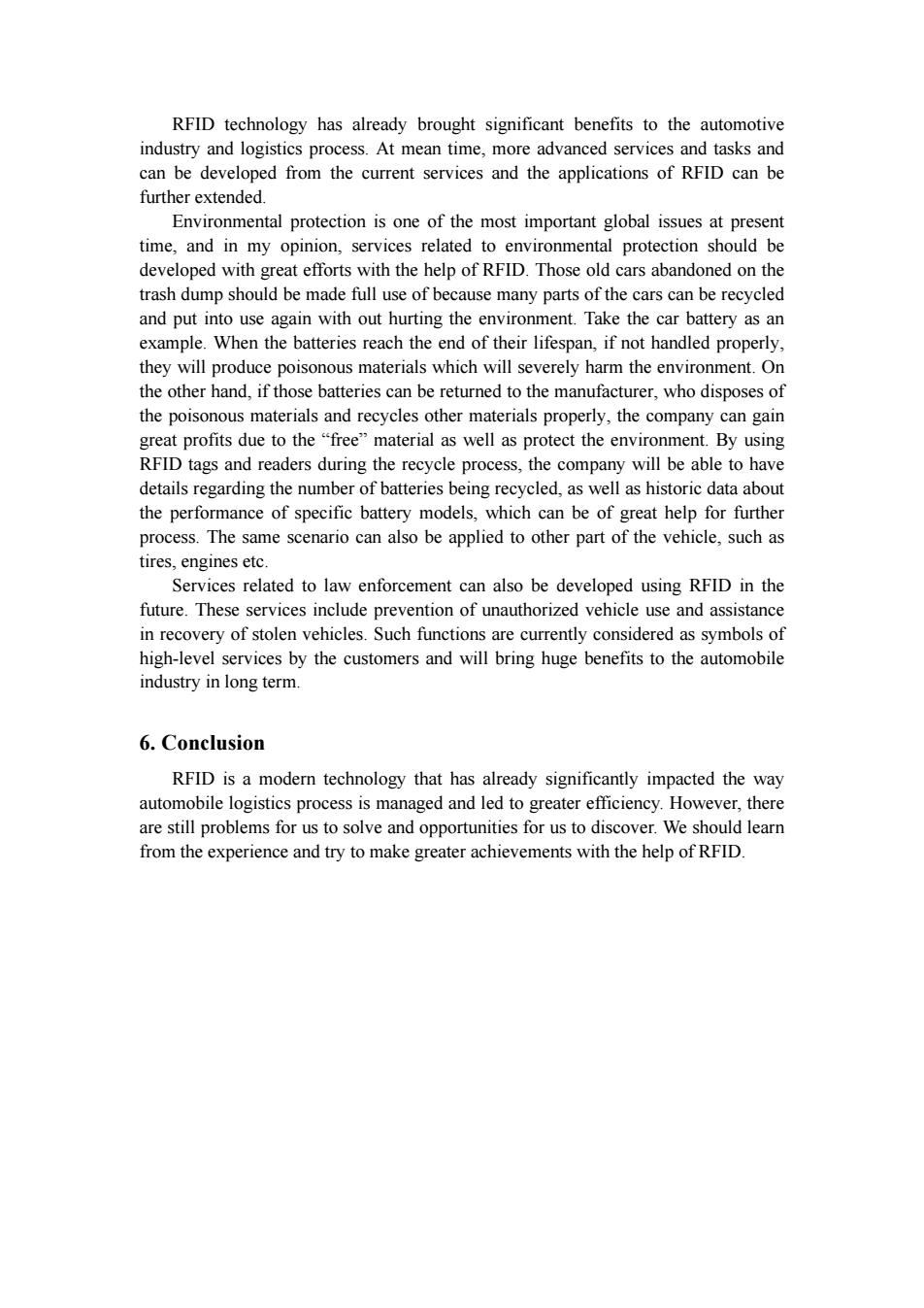
Applications of RFID in logistics process of automobile and related automotive products 5090309542周剑鸣 1.What is RFID? RFID-Radio Frequency Identification-is a technology where people use a wireless non-contact system that uses radio frequency electromagnetic fields to transfer data from a tag attached to an object,for the purposes of automatic identification and tracking.The tags can be used to read electronic product codes,as well as to record desired information for various usages.RFID tags are currently used in many industries.An RFID tag attached to an automobile can be used to track its complete logistic progress and provide necessary technical support. 2.How RFID functions? For example,each automobile is tagged with an RFID transponder.As automobiles pass through a certain section of the logistic progress,the transponder will send signals and data to the reader located on a gate.Then all information obtained is passed to the central computer server through the reader's antenna.After that,information will be filtered and processed for different usages,including manufacturing,inventory management and product tracking. 3.Applications of RFID in logistics process of automobile and related automotive products (1)Manufacturing A Georgia utility car maker implemented RFID tags in the manufacturing process of a new high-end car.An active RFID tag is permanently installed on every assembly carriage.At each stop on the assembly line,the carriage passes a reader that send the car's identifying data to a manufacturing execution system.Then the software can determine which option should be installed and which requirement should be fulfilled. The process replaces the use of printed instructions and cut the time of assembling a new car from 88 minutes to 45. Similar result can be found in Continental Tire plant.After installing internet-based RFID tags,the company's French factory is producing 5000 more tires per day,while decreasing the waste of materials by 20%. From the two similar cases above,we know that the implement of RFID technology can effectively help manufacturers to increase productivity and quality
Applications of RFID in logistics process of automobile and related automotive products 5090309542 周剑鸣 1. What is RFID? RFID——Radio Frequency Identification—— is a technology where people use a wireless non-contact system that uses radio frequency electromagnetic fields to transfer data from a tag attached to an object, for the purposes of automatic identification and tracking. The tags can be used to read electronic product codes, as well as to record desired information for various usages. RFID tags are currently used in many industries. An RFID tag attached to an automobile can be used to track its complete logistic progress and provide necessary technical support. 2. How RFID functions? For example, each automobile is tagged with an RFID transponder. As automobiles pass through a certain section of the logistic progress, the transponder will send signals and data to the reader located on a gate. Then all information obtained is passed to the central computer server through the reader's antenna. After that, information will be filtered and processed for different usages, including manufacturing, inventory management and product tracking. 3. Applications of RFID in logistics process of automobile and related automotive products (1) Manufacturing A Georgia utility car maker implemented RFID tags in the manufacturing process of a new high-end car. An active RFID tag is permanently installed on every assembly carriage. At each stop on the assembly line, the carriage passes a reader that send the car’s identifying data to a manufacturing execution system. Then the software can determine which option should be installed and which requirement should be fulfilled. The process replaces the use of printed instructions and cut the time of assembling a new car from 88 minutes to 45. Similar result can be found in Continental Tire plant. After installing internet-based RFID tags, the company’s French factory is producing 5000 more tires per day, while decreasing the waste of materials by 20%. From the two similar cases above, we know that the implement of RFID technology can effectively help manufacturers to increase productivity and quality

while reduce waste and cost.In traditional manufacturing process,more manual operations are needed.If a carrier is not where it is expected to be and there are no use of RFID tags,a worker has to start looking for it manually.However,manual tracking was not only time-consuming but also inaccurate and unreliable.The company often loses track of semi-products and other important materials,which will largely impact or delay the whole production process and may even bring extra cost and waste.On the contrary,the proper use of RFID can prevent or even eliminate the drawbacks caused by manual operations.Lost carrier can be tracked automatically and very fast with the help of RFID,thus accelerating the process and increasing the quality of the products.It is obvious that RFID will also save manual labor,which implies less labor cost. (2)Inventory management and distribution At four Minnesota stores,a major U.S.automotive battery supplier has added RFID technology to storage,making it possible for the company to view the locations of its products and replenish inventory and stock at the appropriate times,thus enabling it to provide improved services to its distributors,dealers and retailers. The case above implies that the application of RFID in inventory and distribution can lead to reduced inventory and reduction in out of stock.This is mainly achieved through improved visibility and reduction in order cycle time,which leads to reduction in the bullwhip effect and better forecasts.In the case above,under traditional condition,the supplier may sell more of a specific model of automotive batteries than it was aware,and its drivers might not deliver a sufficient quantity of that model.On the other hand,a driver might deliver too many batteries of a particular type,which could then lead to over-stocking at the store.These are usually caused by lack of visibility.With the help of RFID,both situations can be avoided. The supplier can view the number of batteries sold with higher accuracy and develop a strategy in which the company would send a specific number of batteries of particular types based on sales demand at each location.This information also enables its delivery drivers to better manage their time,by providing the correct quantities and types of batteries as needed,and not to locations at which batteries do not require replenishment.Reduction in order cycle time yields reduction in both cycle stock and safety stock while improved visibility and forecasts yields reduction in safety stock and out of stock,improving its service to all clients and customers.At mean time, total cost for inventory management and distribution will drop a lot because lower safety stock implies less maintenance cost and reduced labor involved implies reduction in labor expenses. (3)Product tracking Tire manufacturer Michelin implanted RFID tags on some tires to track their performance over a period of time.Its engineers have developed an RFID transponder that is embedded to the tire during manufacturing.There are three main uses for tire RFID tags,including identification,operating conditions that include tire pressure
while reduce waste and cost. In traditional manufacturing process, more manual operations are needed. If a carrier is not where it is expected to be and there are no use of RFID tags, a worker has to start looking for it manually. However, manual tracking was not only time-consuming but also inaccurate and unreliable. The company often loses track of semi-products and other important materials, which will largely impact or delay the whole production process and may even bring extra cost and waste. On the contrary, the proper use of RFID can prevent or even eliminate the drawbacks caused by manual operations. Lost carrier can be tracked automatically and very fast with the help of RFID, thus accelerating the process and increasing the quality of the products. It is obvious that RFID will also save manual labor, which implies less labor cost. (2) Inventory management and distribution At four Minnesota stores, a major U.S. automotive battery supplier has added RFID technology to storage, making it possible for the company to view the locations of its products and replenish inventory and stock at the appropriate times, thus enabling it to provide improved services to its distributors, dealers and retailers. The case above implies that the application of RFID in inventory and distribution can lead to reduced inventory and reduction in out of stock. This is mainly achieved through improved visibility and reduction in order cycle time, which leads to reduction in the bullwhip effect and better forecasts. In the case above, under traditional condition, the supplier may sell more of a specific model of automotive batteries than it was aware, and its drivers might not deliver a sufficient quantity of that model. On the other hand, a driver might deliver too many batteries of a particular type, which could then lead to over-stocking at the store. These are usually caused by lack of visibility. With the help of RFID, both situations can be avoided. The supplier can view the number of batteries sold with higher accuracy and develop a strategy in which the company would send a specific number of batteries of particular types based on sales demand at each location. This information also enables its delivery drivers to better manage their time, by providing the correct quantities and types of batteries as needed, and not to locations at which batteries do not require replenishment. Reduction in order cycle time yields reduction in both cycle stock and safety stock while improved visibility and forecasts yields reduction in safety stock and out of stock, improving its service to all clients and customers. At mean time, total cost for inventory management and distribution will drop a lot because lower safety stock implies less maintenance cost and reduced labor involved implies reduction in labor expenses. (3) Product tracking Tire manufacturer Michelin implanted RFID tags on some tires to track their performance over a period of time. Its engineers have developed an RFID transponder that is embedded to the tire during manufacturing. There are three main uses for tire RFID tags, including identification, operating conditions that include tire pressure

monitoring systems,and automobile performance,where a tire can actually sense road conditions and adjust automobile's performance automatically,thereby improving safety and efficiency. In addition to storing valuable information,such RFID can also provide benefits for the logistics process.Without RFID technology,the workers must remove the cap from each tire's valve and attach a pressure gauge in order to measure the pressure. Then they must manually write down the resulting measurements,as well as the serial number printed on each tire's sidewall,which can sometimes be difficult to read if part of the tire has been rubbed.It usually takes the operator a total of 15 minutes to finish the complete set of procedures mentioned above.However,with the RFID tags installed,all of a vehicle's tires can be fully inspected in less than 5 minutes.The data collected by the inspection tools can then be stored either on tire service provider's or the customer's database for future use.In a word,RFID can provide companies with improved logistics performance and higher service level by reducing manual inspections,saving numerous work hours and improving efficiency.Furthermore,the technology can reduce the time needed to process return while increasing distribution accuracy and reducing lost sales. It was reported that large numbers of London's double-decker buses,equipped with RFID tires,had already been in service during the 2012 Olympic Games. 4.Problems to be solved Although RFID technology has already been widely used in the logistics process of automobile and related automotive products,there are still problems remaining to be solved to improve its application. For companies selling a low volume of expensive goods such as automobiles or other automotive products,the profits are quite high so that the cost of RFID tags may not be a big problem,though reduction in tag cost is always preferable. The most serious problem of RFID in automotive industry and logistics process is its reliability.According to industry analysts,RFID tags are functioning at only 80% success rates.Antennas sometimes separate from their tags.And even when the tags stay intact,tag readers are not always reliable,especially in the process of automobile manufacturing and testing.The environment of the factory can posed several challenges.Since typical car factories have a lot of steel and other metal materials in the manufacturing rooms,we have to face the issues such as signal reflection,which will result in non-accurate location and data measurement.However,the accuracy of measurement is a key element to the improvement of whole logistics process.And the unreliable information may cause serious problems. Another problem is that there are still no common international standards for tags, which will definitely exert certain negative effect on the use of RFID in automotive industry.Other issues with RFID that haven't been resolves relate to policy issues such as privacy concerns. 5.Services to be developed using RFID
monitoring systems, and automobile performance, where a tire can actually sense road conditions and adjust automobile’s performance automatically, thereby improving safety and efficiency. In addition to storing valuable information, such RFID can also provide benefits for the logistics process. Without RFID technology, the workers must remove the cap from each tire's valve and attach a pressure gauge in order to measure the pressure. Then they must manually write down the resulting measurements, as well as the serial number printed on each tire's sidewall, which can sometimes be difficult to read if part of the tire has been rubbed. It usually takes the operator a total of 15 minutes to finish the complete set of procedures mentioned above. However, with the RFID tags installed, all of a vehicle's tires can be fully inspected in less than 5 minutes. The data collected by the inspection tools can then be stored either on tire service provider's or the customer's database for future use. In a word, RFID can provide companies with improved logistics performance and higher service level by reducing manual inspections, saving numerous work hours and improving efficiency. Furthermore, the technology can reduce the time needed to process return while increasing distribution accuracy and reducing lost sales. It was reported that large numbers of London's double-decker buses, equipped with RFID tires, had already been in service during the 2012 Olympic Games. 4. Problems to be solved Although RFID technology has already been widely used in the logistics process of automobile and related automotive products, there are still problems remaining to be solved to improve its application. For companies selling a low volume of expensive goods such as automobiles or other automotive products, the profits are quite high so that the cost of RFID tags may not be a big problem, though reduction in tag cost is always preferable. The most serious problem of RFID in automotive industry and logistics process is its reliability. According to industry analysts, RFID tags are functioning at only 80% success rates. Antennas sometimes separate from their tags. And even when the tags stay intact, tag readers are not always reliable, especially in the process of automobile manufacturing and testing. The environment of the factory can posed several challenges. Since typical car factories have a lot of steel and other metal materials in the manufacturing rooms, we have to face the issues such as signal reflection, which will result in non-accurate location and data measurement. However, the accuracy of measurement is a key element to the improvement of whole logistics process. And the unreliable information may cause serious problems. Another problem is that there are still no common international standards for tags, which will definitely exert certain negative effect on the use of RFID in automotive industry. Other issues with RFID that haven’t been resolves relate to policy issues such as privacy concerns. 5. Services to be developed using RFID

RFID technology has already brought significant benefits to the automotive industry and logistics process.At mean time,more advanced services and tasks and can be developed from the current services and the applications of RFID can be further extended. Environmental protection is one of the most important global issues at present time,and in my opinion,services related to environmental protection should be developed with great efforts with the help of RFID.Those old cars abandoned on the trash dump should be made full use of because many parts of the cars can be recycled and put into use again with out hurting the environment.Take the car battery as an example.When the batteries reach the end of their lifespan,if not handled properly, they will produce poisonous materials which will severely harm the environment.On the other hand,if those batteries can be returned to the manufacturer,who disposes of the poisonous materials and recycles other materials properly,the company can gain great profits due to the "free"material as well as protect the environment.By using RFID tags and readers during the recycle process,the company will be able to have details regarding the number of batteries being recycled,as well as historic data about the performance of specific battery models,which can be of great help for further process.The same scenario can also be applied to other part of the vehicle,such as tires,engines etc. Services related to law enforcement can also be developed using RFID in the future.These services include prevention of unauthorized vehicle use and assistance in recovery of stolen vehicles.Such functions are currently considered as symbols of high-level services by the customers and will bring huge benefits to the automobile industry in long term. 6.Conclusion RFID is a modern technology that has already significantly impacted the way automobile logistics process is managed and led to greater efficiency.However,there are still problems for us to solve and opportunities for us to discover.We should learn from the experience and try to make greater achievements with the help of RFID
RFID technology has already brought significant benefits to the automotive industry and logistics process. At mean time, more advanced services and tasks and can be developed from the current services and the applications of RFID can be further extended. Environmental protection is one of the most important global issues at present time, and in my opinion, services related to environmental protection should be developed with great efforts with the help of RFID. Those old cars abandoned on the trash dump should be made full use of because many parts of the cars can be recycled and put into use again with out hurting the environment. Take the car battery as an example. When the batteries reach the end of their lifespan, if not handled properly, they will produce poisonous materials which will severely harm the environment. On the other hand, if those batteries can be returned to the manufacturer, who disposes of the poisonous materials and recycles other materials properly, the company can gain great profits due to the “free” material as well as protect the environment. By using RFID tags and readers during the recycle process, the company will be able to have details regarding the number of batteries being recycled, as well as historic data about the performance of specific battery models, which can be of great help for further process. The same scenario can also be applied to other part of the vehicle, such as tires, engines etc. Services related to law enforcement can also be developed using RFID in the future. These services include prevention of unauthorized vehicle use and assistance in recovery of stolen vehicles. Such functions are currently considered as symbols of high-level services by the customers and will bring huge benefits to the automobile industry in long term. 6. Conclusion RFID is a modern technology that has already significantly impacted the way automobile logistics process is managed and led to greater efficiency. However, there are still problems for us to solve and opportunities for us to discover. We should learn from the experience and try to make greater achievements with the help of RFID